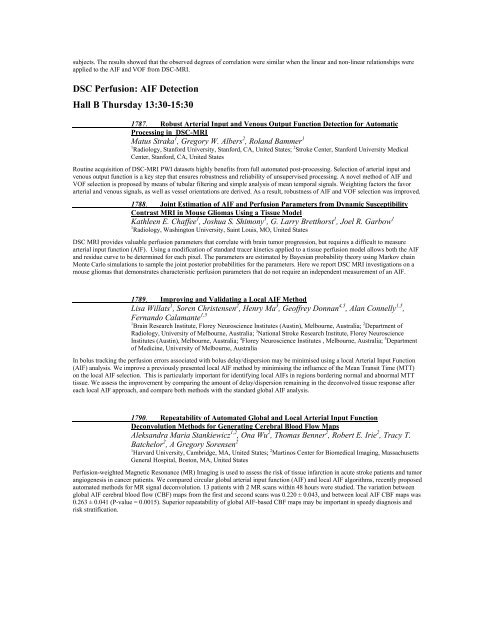Traditional Posters: Diffusion & Perfusion - ismrm
Traditional Posters: Diffusion & Perfusion - ismrm
Traditional Posters: Diffusion & Perfusion - ismrm
You also want an ePaper? Increase the reach of your titles
YUMPU automatically turns print PDFs into web optimized ePapers that Google loves.
subjects. The results showed that the observed degrees of correlation were similar when the linear and non-linear relationships were<br />
applied to the AIF and VOF from DSC-MRI.<br />
DSC <strong>Perfusion</strong>: AIF Detection<br />
Hall B Thursday 13:30-15:30<br />
1787. Robust Arterial Input and Venous Output Function Detection for Automatic<br />
Processing in DSC-MRI<br />
Matus Straka 1 , Gregory W. Albers 2 , Roland Bammer 1<br />
1 Radiology, Stanford University, Stanford, CA, United States; 2 Stroke Center, Stanford University Medical<br />
Center, Stanford, CA, United States<br />
Routine acquisition of DSC-MRI PWI datasets highly benefits from full automated post-processing. Selection of arterial input and<br />
venous output function is a key step that ensures robustness and reliability of unsupervised processing. A novel method of AIF and<br />
VOF selection is proposed by means of tubular filtering and simple analysis of mean temporal signals. Weighting factors the favor<br />
arterial and venous signals, as well as vessel orientations are derived. As a result, robustness of AIF and VOF selection was improved.<br />
1788. Joint Estimation of AIF and <strong>Perfusion</strong> Parameters from Dynamic Susceptibility<br />
Contrast MRI in Mouse Gliomas Using a Tissue Model<br />
Kathleen E. Chaffee 1 , Joshua S. Shimony 1 , G. Larry Bretthorst 1 , Joel R. Garbow 1<br />
1 Radiology, Washington University, Saint Louis, MO, United States<br />
DSC MRI provides valuable perfusion parameters that correlate with brain tumor progression, but requires a difficult to measure<br />
arterial input function (AIF). Using a modification of standard tracer kinetics applied to a tissue perfusion model allows both the AIF<br />
and residue curve to be determined for each pixel. The parameters are estimated by Bayesian probability theory using Markov chain<br />
Monte Carlo simulations to sample the joint posterior probabilities for the parameters. Here we report DSC MRI investigations on a<br />
mouse gliomas that demonstrates characteristic perfusion parameters that do not require an independent measurement of an AIF.<br />
1789. Improving and Validating a Local AIF Method<br />
Lisa Willats 1 , Soren Christensen 2 , Henry Ma 3 , Geoffrey Donnan 4,5 , Alan Connelly 1,5 ,<br />
Fernando Calamante 1,5<br />
1 Brain Research Institute, Florey Neuroscience Institutes (Austin), Melbourne, Australia; 2 Department of<br />
Radiology, University of Melbourne, Australia; 3 National Stroke Research Institute, Florey Neuroscience<br />
Institutes (Austin), Melbourne, Australia; 4 Florey Neuroscience Institutes , Melbourne, Australia; 5 Department<br />
of Medicine, University of Melbourne, Australia<br />
In bolus tracking the perfusion errors associated with bolus delay/dispersion may be minimised using a local Arterial Input Function<br />
(AIF) analysis. We improve a previously presented local AIF method by minimising the influence of the Mean Transit Time (MTT)<br />
on the local AIF selection. This is particularly important for identifying local AIFs in regions bordering normal and abnormal MTT<br />
tissue. We assess the improvement by comparing the amount of delay/dispersion remaining in the deconvolved tissue response after<br />
each local AIF approach, and compare both methods with the standard global AIF analysis.<br />
1790. Repeatability of Automated Global and Local Arterial Input Function<br />
Deconvolution Methods for Generating Cerebral Blood Flow Maps<br />
Aleksandra Maria Stankiewicz 1,2 , Ona Wu 2 , Thomas Benner 2 , Robert E. Irie 2 , Tracy T.<br />
Batchelor 2 , A Gregory Sorensen 2<br />
1 Harvard University, Cambridge, MA, United States; 2 Martinos Center for Biomedical Imaging, Massachusetts<br />
General Hospital, Boston, MA, United States<br />
<strong>Perfusion</strong>-weighted Magnetic Resonance (MR) Imaging is used to assess the risk of tissue infarction in acute stroke patients and tumor<br />
angiogenesis in cancer patients. We compared circular global arterial input function (AIF) and local AIF algorithms, recently proposed<br />
automated methods for MR signal deconvolution. 13 patients with 2 MR scans within 48 hours were studied. The variation between<br />
global AIF cerebral blood flow (CBF) maps from the first and second scans was 0.220 ± 0.043, and between local AIF CBF maps was<br />
0.263 ± 0.041 (P-value = 0.0015). Superior repeatability of global AIF-based CBF maps may be important in speedy diagnosis and<br />
risk stratification.















